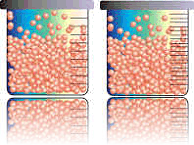![]()
In order that the computer can manage the signals received by the single pixels, they must be converted to numbers. To do so it is used a device said A/D (analogical/Digital) converter . This device turns the entry tension into sequence of bits.
The number of bits, on which the outgoing value is codified, classifies the converters. Typically you can find converters at 8,10,12,14,16 bits. Major it is the bit number, more refined is the quantization of the signal. In fact, if n is the number of bits, the outgoing signal can assume 2 n different values:
![]()
Affinché il computer possa gestire i segnali ricevuti dai singoli pixel, essi devono essere convertiti in numeri. Per far questo si utilizza un dispositivo detto convertitore A/D (Analogico/Digitale), che trasforma la tensione di ingresso in una sequenza di bit.
I convertitori sono classificati in base al numero di bit sui quali viene codificato il valore in uscita, tipicamente si trovano convertitori a 8,10,12,14,16 bit. Maggiore e' il numero di bit, piu' raffinata e' la quantizzazione del segnale. Infatti, se n e' il numero di bit, il segnale in uscita puo' assumere 2n valori differenti:
BIT |
GRAY SHADES |
8 |
256 |
10 |
1024 |
12 |
4096 |
14 |
16384 |
16 |
65536 |
Instinctively you would to ask why a converter is not always used of 16 bits, since it has the widest range. When you have to choose a converter, you must however consider a series of factors.
First of all, major it is the bit number, slower will be the conversion process. This represents a strong limit when it is necessary to read images acquired by sensors of big dimension or to take realtime readings .
For example, an A/D good converter of 16 bits has a time of conversion of 4Mpix/s: it can read maximum 4.000.000 pixels per second. If your sensor is 4096 x4096, you will need almost 5 second to read it.
Another limit is represented by the space necessary to memorize the images. With a converter of 16 bits, 2 memory bytes are necessary for every pixel. If our sensor a 1300 x1024, 2,6 Mbs of memory, will be necessary while with a converter of 8 bit only 1,3 Mbs.
A further factor which it is necessary to consider to choose the type of converter is the reading noise. It shows itself as a random signal and he goes to add to the useful signal, creating an indetermination amount. Major it is the noise, minor will be the accuracy of the measure. It is important since it determines dynamics of the camera. This parameter shows the capacity to distinguish various levels inside an image. You can easily calculate its value dividing the FWC of the camerafor the above-mentioned noise. For example if a KAF3200 (FWC of 50.000) is mounted on your Discovery, the dynamics will be of 5000 (in binning 1 x1), being the noise of 10e-. If you know this value you can choose the A/D converter: in the example, a converter of 14 bit (16384 levels) would be more than sufficient, while a converter with wider dynamics totally wasted.
Going back to the initial comparison between pixel and glasses, it is as though we had to measure the amount of water while it is boiling.
Istintivamente verrebbe da chiedersi perché non si usi sempre un convertitore a 16 bit, dato che e' quello con il range piu' ampio. Quando si deve scegliere un convertitore, devono essere tuttavia considerati una serie di fattori.
Anzitutto, maggiore e' il numero di bit, piu' lento sara' il processo di conversione. Questo rappresenta un forte limite quando si devono leggere immagini acquisite da sensori di grande dimensione, oppure quando bisogna fare letture in tempo reale. Per esempio, un buon convertitore A/D a 16 bit ha un tempo di conversione di 4 Mpix/s: esso puo' leggere al massimo 4.000.000 di pixel al secondo. Se il nostro sensore e' un 4096x4096, impiegheremo quasi 5 secondi per leggerlo.
Un altro limite e' rappresentato dallo spazio necessario per memorizzare le immagini. Con un convertitore a 16 bit sono necessari 2 byte di memoria per ogni pixel. Se il nostro sensore e' un 1300x1024, saranno necessari 2,6Mb di memoria, mentre con un convertitore a 8 bit bastano 1,3Mb.
Un ulteriore fattore del quale si deve tenere conto quando si sceglie il tipo di convertitore e' il rumore di lettura. Esso si manifesta come un segnale casuale, che si va a sommare al segnale utile, creando una quota di indeterminazione. Maggiore e' il rumore, minore sara' l’accuratezza della misura. E’ importante poiché determina la dinamica della camera. Questo parametro indica la capacita' di distinguere livelli diversi all’interno di un’immagine. Il valore puo' essere facilmente calcolato dividendo la FWC della camera per il suddetto rumore. Per esempio, se sulla vostra Discovery e' montato un KAF3200, che ha una FWC di 50.000, essendo il rumore di 10e-, la dinamica sara' di 5000 (in binning 1x1). Noto questo valore si puo' scegliere il convertitore A/D: nell’esempio un convertitore a 14 bit (16384 livelli) sarebbe piu' che sufficiente, mentre uno con dinamica piu' ampia totalmente sprecato.
Tornando al paragone iniziale tra pixel e bicchieri, e' come se dovessimo misurare la quantita' di acqua mentre sta bollendo.
The image shows two equal glasses with a different scale of measurement: that on the right has a more precise scalethan that on the left. It is easy to note that, having a scale of more careful measurement is pratically useless, being the particles in movement.
A more exact measure could only do with a stabler liquid.
Under some conditions there is the possibility to improve our measure by averages, however, must be complied with underlying conditions.
The noise must be of type uncorrelated, typically Gaussian, a noise of the type of interference by 50/60 Hz network or a radio frequency source obviates the averages. Ideally, the noise must have a mean value of 0 and a constant variance between a measurement and the other.
The signal flow is constant for each pixel, and this is only applicable to static images.
If this is true we can improve the signal to noise ratio of a value equal to the square root of the number of samples.
In practice, the average of 4 images will give us an increase of S/N of 2 etc.
Nell’immagine sono riportati due bicchieri uguali con una scala di misurazione differente: quello a destra ha una scala piu' precisa di quello di sinistra. E’ facile notare che, essendo le particelle in movimento, e' praticamente inutile avere una scala di misurazione piu' accurata.
Una misura piu' precisa si potrebbe fare soltanto con un liquido piu' stabile.
In alcune condizioni esiste la possibilitá di migliorare la nostra misura facendo medie, devono peró essere rispettate le sottostanti condizioni.
Il rapporto fra segnale e disturbo deve essere di tipo scorrelato, tipicamente gaussiano, un disturbo del tipo interferenza dei 50/60Hz della rete o di una sorgente a radio frequenza rende inutile le medie. Idealmente il rumore deve avere un valor medio di 0 ed una varianza costante fra una misura e l'altra.
Il flusso del segnale é costante per ogni pixel e questo é applicabile solo ad immagini statiche.
Se questo é vero possiamo migliorare il rapporto segnale disturbo di un valore pari alla radice quadrata del numero di campionamenti.
In pratica la media di 4 immagini ci dará in incremento del S/N di 2 etc.


